front brakes Hyundai Santa Fe 2016 Owner's Manual
[x] Cancel search | Manufacturer: HYUNDAI, Model Year: 2016, Model line: Santa Fe, Model: Hyundai Santa Fe 2016Pages: 759, PDF Size: 29.36 MB
Page 540 of 759
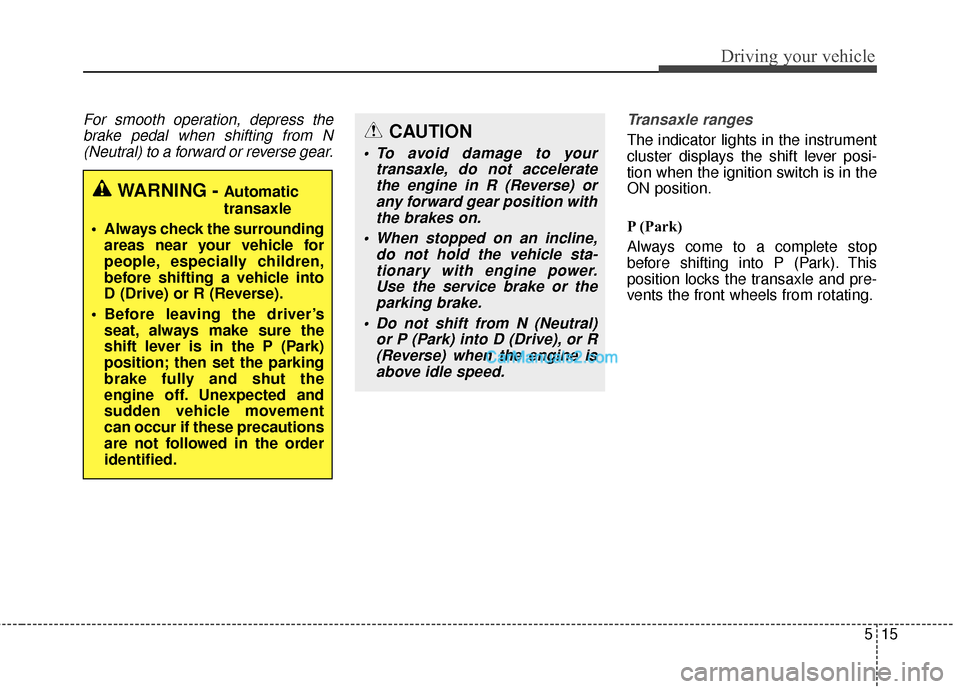
515
Driving your vehicle
For smooth operation, depress thebrake pedal when shifting from N(Neutral) to a forward or reverse gear. Transaxle ranges
The indicator lights in the instrument
cluster displays the shift lever posi-
tion when the ignition switch is in the
ON position.
P (Park)
Always come to a complete stop
before shifting into P (Park). This
position locks the transaxle and pre-
vents the front wheels from rotating.
WARNING - Automatic
transaxle
Always check the surrounding areas near your vehicle for
people, especially children,
before shifting a vehicle into
D (Drive) or R (Reverse).
Before leaving the driver’s seat, always make sure the
shift lever is in the P (Park)
position; then set the parking
brake fully and shut the
engine off. Unexpected and
sudden vehicle movement
can occur if these precautions
are not followed in the order
identified.
CAUTION
To avoid damage to your transaxle, do not acceleratethe engine in R (Reverse) orany forward gear position withthe brakes on.
When stopped on an incline, do not hold the vehicle sta-tionary with engine power.Use the service brake or theparking brake.
Do not shift from N (Neutral) or P (Park) into D (Drive), or R(Reverse) when the engine isabove idle speed.
Page 554 of 759
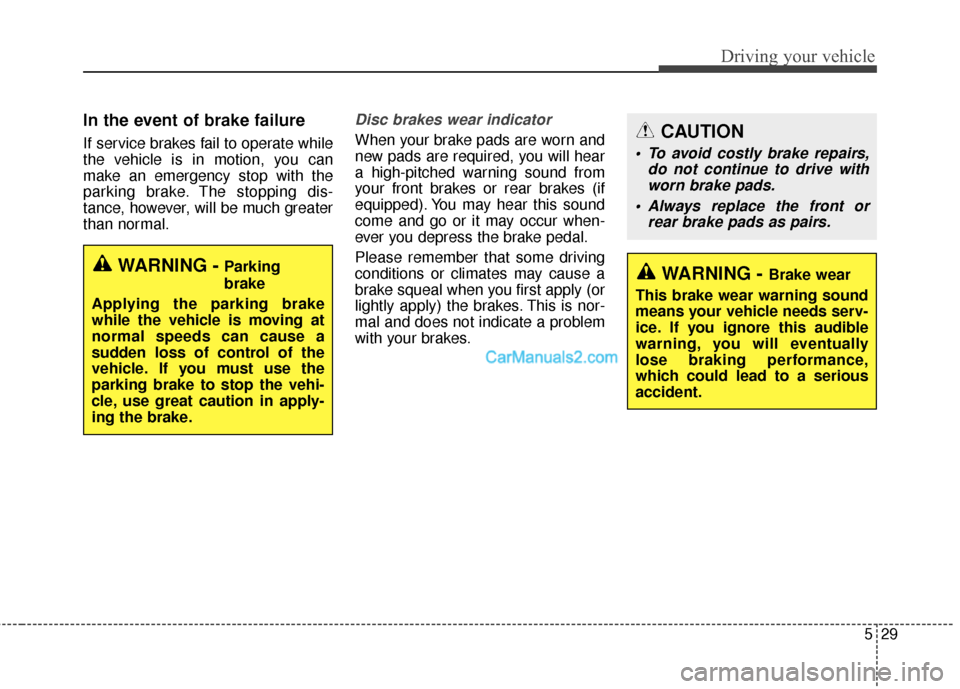
529
Driving your vehicle
In the event of brake failure
If service brakes fail to operate while
the vehicle is in motion, you can
make an emergency stop with the
parking brake. The stopping dis-
tance, however, will be much greater
than normal.
Disc brakes wear indicator
When your brake pads are worn and
new pads are required, you will hear
a high-pitched warning sound from
your front brakes or rear brakes (if
equipped). You may hear this sound
come and go or it may occur when-
ever you depress the brake pedal.
Please remember that some driving
conditions or climates may cause a
brake squeal when you first apply (or
lightly apply) the brakes. This is nor-
mal and does not indicate a problem
with your brakes.
WARNING - Parking
brake
Applying the parking brake
while the vehicle is moving at
normal speeds can cause a
sudden loss of control of the
vehicle. If you must use the
parking brake to stop the vehi-
cle, use great caution in apply-
ing the brake.WARNING - Brake wear
This brake wear warning sound
means your vehicle needs serv-
ice. If you ignore this audible
warning, you will eventually
lose braking performance,
which could lead to a serious
accident.
CAUTION
To avoid costly brake repairs, do not continue to drive withworn brake pads.
Always replace the front or rear brake pads as pairs.
Page 558 of 759
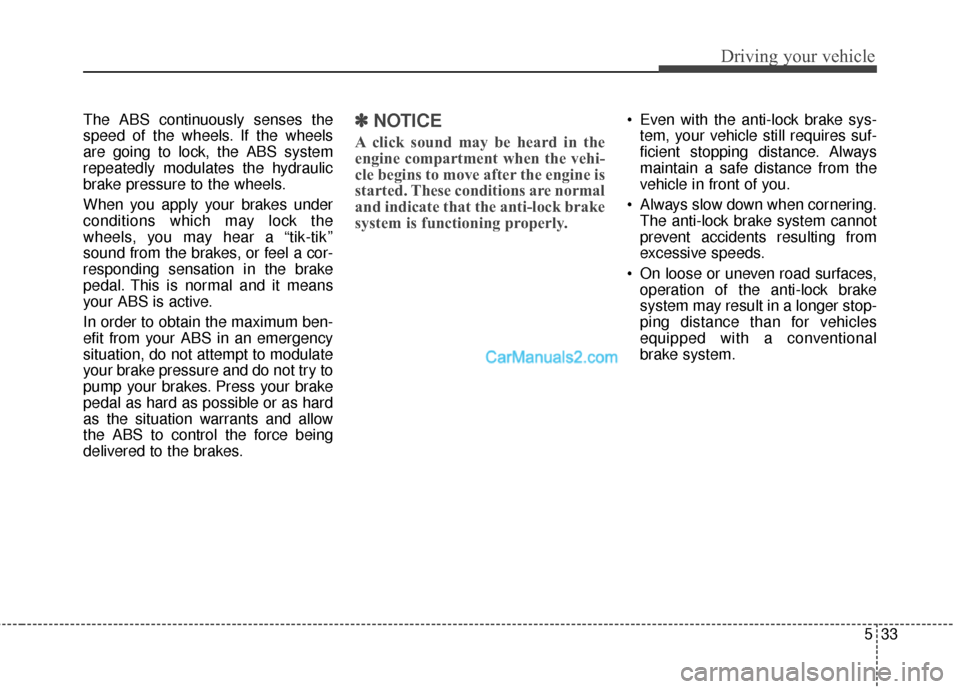
533
Driving your vehicle
The ABS continuously senses the
speed of the wheels. If the wheels
are going to lock, the ABS system
repeatedly modulates the hydraulic
brake pressure to the wheels.
When you apply your brakes under
conditions which may lock the
wheels, you may hear a “tik-tik’’
sound from the brakes, or feel a cor-
responding sensation in the brake
pedal. This is normal and it means
your ABS is active.
In order to obtain the maximum ben-
efit from your ABS in an emergency
situation, do not attempt to modulate
your brake pressure and do not try to
pump your brakes. Press your brake
pedal as hard as possible or as hard
as the situation warrants and allow
the ABS to control the force being
delivered to the brakes.✽ ✽NOTICE
A click sound may be heard in the
engine compartment when the vehi-
cle begins to move after the engine is
started. These conditions are normal
and indicate that the anti-lock brake
system is functioning properly.
Even with the anti-lock brake sys-
tem, your vehicle still requires suf-
ficient stopping distance. Always
maintain a safe distance from the
vehicle in front of you.
Always slow down when cornering. The anti-lock brake system cannot
prevent accidents resulting from
excessive speeds.
On loose or uneven road surfaces, operation of the anti-lock brake
system may result in a longer stop-
ping distance than for vehicles
equipped with a conventional
brake system.
Page 569 of 759
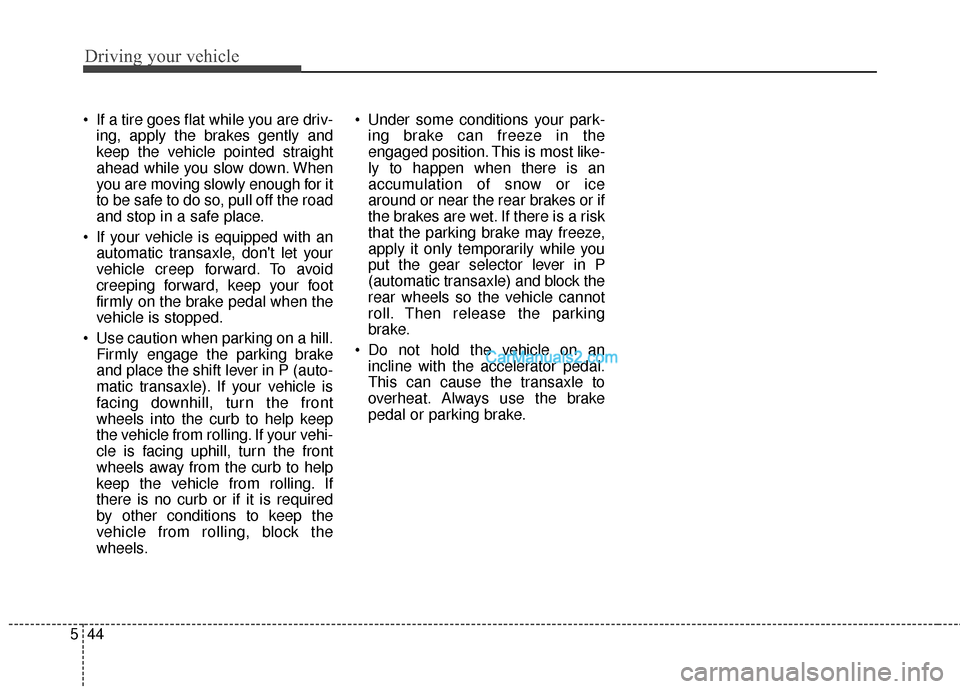
Driving your vehicle
44
5
If a tire goes flat while you are driv-
ing, apply the brakes gently and
keep the vehicle pointed straight
ahead while you slow down. When
you are moving slowly enough for it
to be safe to do so, pull off the road
and stop in a safe place.
If your vehicle is equipped with an automatic transaxle, don't let your
vehicle creep forward. To avoid
creeping forward, keep your foot
firmly on the brake pedal when the
vehicle is stopped.
Use caution when parking on a hill. Firmly engage the parking brake
and place the shift lever in P (auto-
matic transaxle). If your vehicle is
facing downhill, turn the front
wheels into the curb to help keep
the vehicle from rolling. If your vehi-
cle is facing uphill, turn the front
wheels away from the curb to help
keep the vehicle from rolling. If
there is no curb or if it is required
by other conditions to keep the
vehicle from rolling, block the
wheels. Under some conditions your park-
ing brake can freeze in the
engaged position. This is most like-
ly to happen when there is an
accumulation of snow or ice
around or near the rear brakes or if
the brakes are wet. If there is a risk
that the parking brake may freeze,
apply it only temporarily while you
put the gear selector lever in P
(automatic transaxle) and block the
rear wheels so the vehicle cannot
roll. Then release the parking
brake.
Do not hold the vehicle on an incline with the accelerator pedal.
This can cause the transaxle to
overheat. Always use the brake
pedal or parking brake.
Page 594 of 759
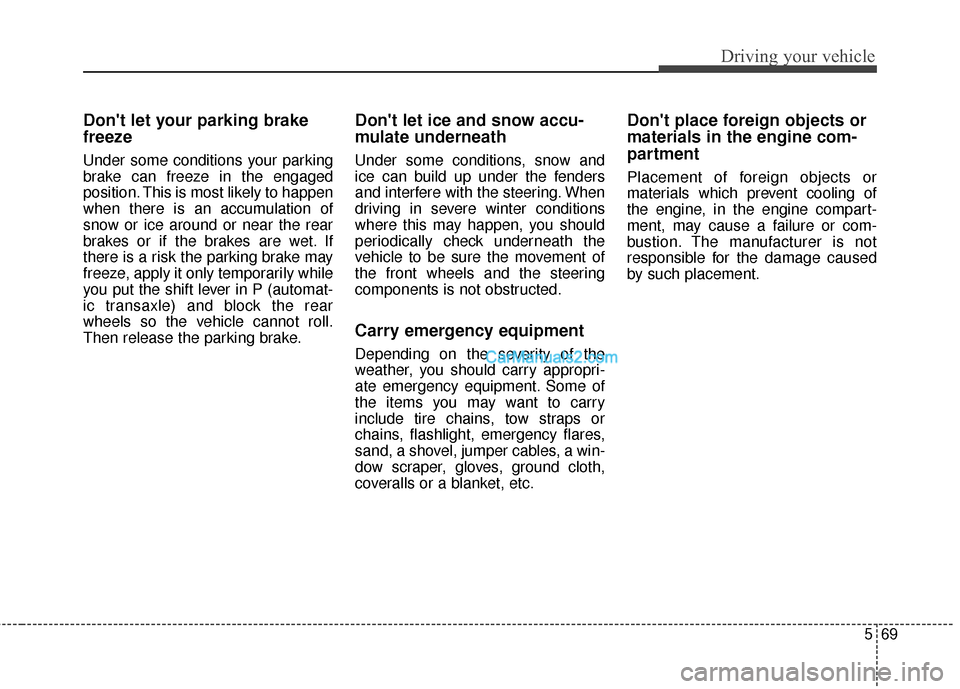
569
Driving your vehicle
Don't let your parking brake
freeze
Under some conditions your parking
brake can freeze in the engaged
position. This is most likely to happen
when there is an accumulation of
snow or ice around or near the rear
brakes or if the brakes are wet. If
there is a risk the parking brake may
freeze, apply it only temporarily while
you put the shift lever in P (automat-
ic transaxle) and block the rear
wheels so the vehicle cannot roll.
Then release the parking brake.
Don't let ice and snow accu-
mulate underneath
Under some conditions, snow and
ice can build up under the fenders
and interfere with the steering. When
driving in severe winter conditions
where this may happen, you should
periodically check underneath the
vehicle to be sure the movement of
the front wheels and the steering
components is not obstructed.
Carry emergency equipment
Depending on the severity of the
weather, you should carry appropri-
ate emergency equipment. Some of
the items you may want to carry
include tire chains, tow straps or
chains, flashlight, emergency flares,
sand, a shovel, jumper cables, a win-
dow scraper, gloves, ground cloth,
coveralls or a blanket, etc.
Don't place foreign objects or
materials in the engine com-
partment
Placement of foreign objects or
materials which prevent cooling of
the engine, in the engine compart-
ment, may cause a failure or com-
bustion. The manufacturer is not
responsible for the damage caused
by such placement.
Page 641 of 759
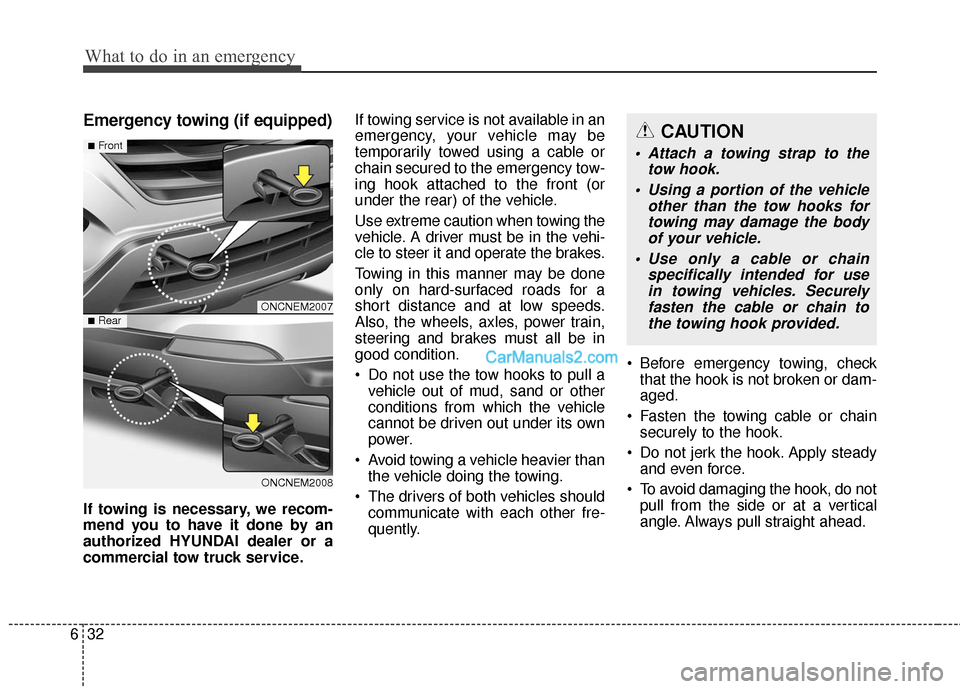
What to do in an emergency
32
6
Emergency towing (if equipped)
If towing is necessary, we recom-
mend you to have it done by an
authorized HYUNDAI dealer or a
commercial tow truck service. If towing service is not available in an
emergency, your vehicle may be
temporarily towed using a cable or
chain secured to the emergency tow-
ing hook attached to the front (or
under the rear) of the vehicle.
Use extreme caution when towing the
vehicle. A driver must be in the vehi-
cle to steer it and operate the brakes.
Towing in this manner may be done
only on hard-surfaced roads for a
short distance and at low speeds.
Also, the wheels, axles, power train,
steering and brakes must all be in
good condition.
Do not use the tow hooks to pull a
vehicle out of mud, sand or other
conditions from which the vehicle
cannot be driven out under its own
power.
Avoid towing a vehicle heavier than the vehicle doing the towing.
The drivers of both vehicles should communicate with each other fre-
quently. Before emergency towing, check
that the hook is not broken or dam-
aged.
Fasten the towing cable or chain securely to the hook.
Do not jerk the hook. Apply steady and even force.
To avoid damaging the hook, do not pull from the side or at a vertical
angle. Always pull straight ahead.
CAUTION
Attach a towing strap to the tow hook.
Using a portion of the vehicle other than the tow hooks fortowing may damage the bodyof your vehicle.
Use only a cable or chain specifically intended for usein towing vehicles. Securelyfasten the cable or chain tothe towing hook provided.
ONCNEM2007
ONCNEM2008
■Front
■Rear
Page 642 of 759
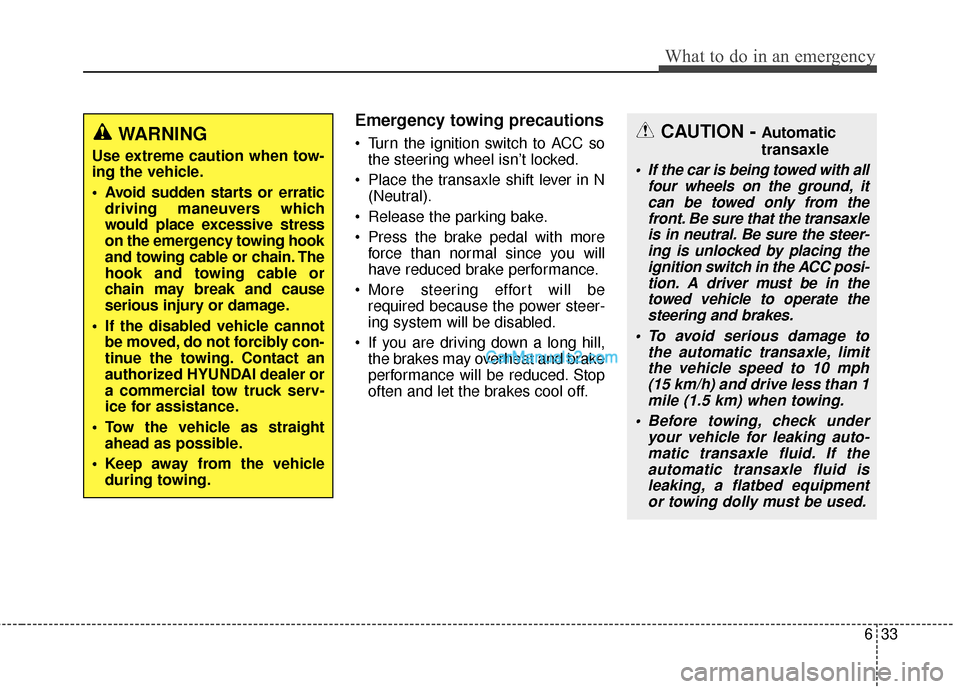
633
What to do in an emergency
Emergency towing precautions
Turn the ignition switch to ACC sothe steering wheel isn’t locked.
Place the transaxle shift lever in N (Neutral).
Release the parking bake.
Press the brake pedal with more force than normal since you will
have reduced brake performance.
More steering effort will be required because the power steer-
ing system will be disabled.
If you are driving down a long hill, the brakes may overheat and brake
performance will be reduced. Stop
often and let the brakes cool off.CAUTION - Automatic
transaxle
If the car is being towed with all four wheels on the ground, itcan be towed only from thefront. Be sure that the transaxleis in neutral. Be sure the steer-ing is unlocked by placing theignition switch in the ACC posi-tion. A driver must be in thetowed vehicle to operate thesteering and brakes.
To avoid serious damage to the automatic transaxle, limitthe vehicle speed to 10 mph(15 km/h) and drive less than 1mile (1.5 km) when towing.
Before towing, check under your vehicle for leaking auto-matic transaxle fluid. If theautomatic transaxle fluid isleaking, a flatbed equipmentor towing dolly must be used.
WARNING
Use extreme caution when tow-
ing the vehicle.
Avoid sudden starts or erratic driving maneuvers which
would place excessive stress
on the emergency towing hook
and towing cable or chain. The
hook and towing cable or
chain may break and cause
serious injury or damage.
If the disabled vehicle cannot be moved, do not forcibly con-
tinue the towing. Contact an
authorized HYUNDAI dealer or
a commercial tow truck serv-
ice for assistance.
Tow the vehicle as straight ahead as possible.
Keep away from the vehicle during towing.
Page 753 of 759
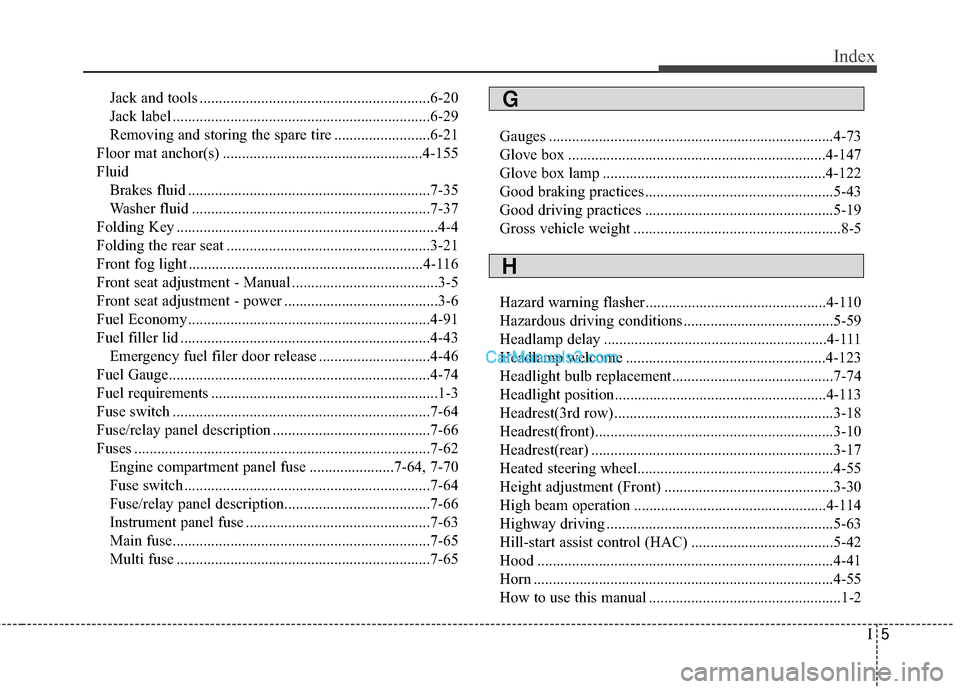
I5
Index
Jack and tools ............................................................6-20
Jack label ...................................................................6-29
Removing and storing the spare tire .........................6-21
Floor mat anchor(s) ....................................................4-155
Fluid Brakes fluid ...............................................................7-35
Washer fluid ..............................................................7-37
Folding Key ....................................................................4-4
Folding the rear seat .....................................................3-21
Front fog light .............................................................4-116
Front seat adjustment - Manual ......................................3-5
Front seat adjustment - power ........................................3-6
Fuel Economy ...............................................................4-91
Fuel filler lid .................................................................4-43 Emergency fuel filer door release .............................4-46
Fuel Gauge....................................................................4-74\
Fuel requirements ...........................................................1-3
Fuse switch ...................................................................7-64
Fuse/relay panel description .........................................7-66
Fuses ........................................................................\
.....7-62 Engine compartment panel fuse ......................7-64, 7-70
Fuse switch ................................................................7-64
Fuse/relay panel description......................................7-66
Instrument panel fuse ................................................7-63
Main fuse...................................................................7-65
Multi fuse ..................................................................7-65 Gauges ........................................................................\
..4-73
Glove box ...................................................................4-147\
Glove box lamp ..........................................................4-122
Good braking practices .................................................5-43
Good driving practices .................................................5-19
Gross vehicle weight ......................................................8-5
Hazard warning flasher...............................................4-110
Hazardous driving conditions .......................................5-59
Headlamp delay ..........................................................4-111
Headlamp welcome ....................................................4-123
Headlight bulb replacement..........................................7-74
Headlight position.......................................................4-113
Headrest(3rd row) .........................................................3-18
Headrest(front)..............................................................3-10
Headrest(rear) ...............................................................3-17
Heated steering wheel...................................................4-55
Height adjustment (Front) ............................................3-30
High beam operation ..................................................4-114
Highway driving ...........................................................5-63
Hill-start assist control (HAC) .....................................5-42
Hood ........................................................................\
.....4-41
Horn ........................................................................\
......4-55
How to use this manual ..................................................1-2G
H
Page 756 of 759
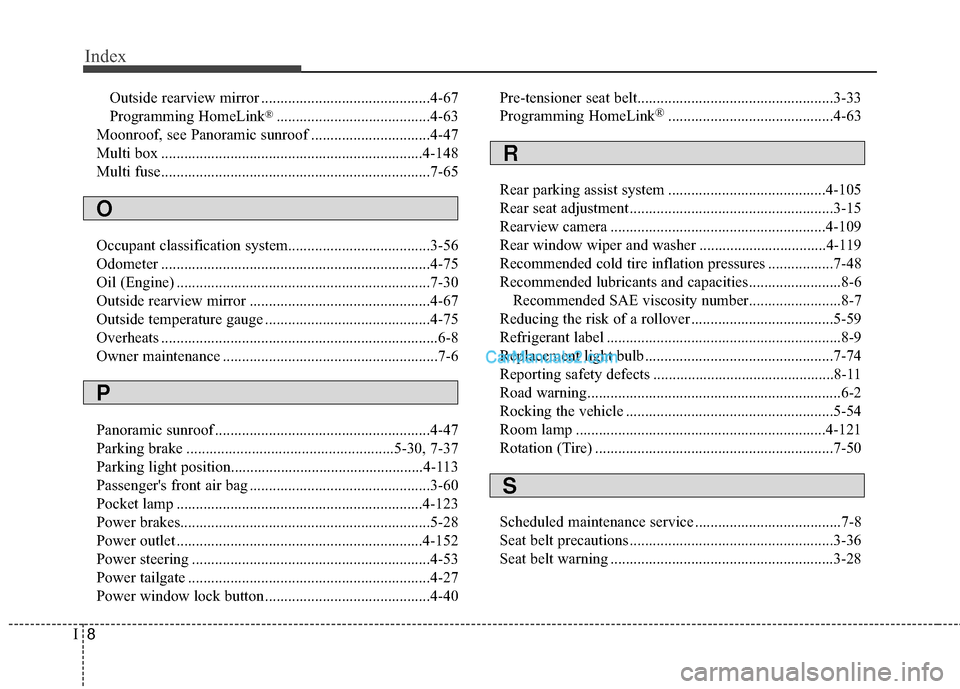
Index
8I
Outside rearview mirror ............................................4-67
Programming HomeLink®........................................4-63
Moonroof, see Panoramic sunroof ...............................4-47
Multi box ....................................................................4-14\
8
Multi fuse......................................................................7-\
65
Occupant classification system.....................................3-56
Odometer ......................................................................4-\
75
Oil (Engine) ..................................................................7-30
Outside rearview mirror ...............................................4-67
Outside temperature gauge ...........................................4-75
Overheats ........................................................................\
6-8
Owner maintenance ........................................................7-6
Panoramic sunroof ........................................................4-47
Parking brake ......................................................5-30, 7-37
Parking light position..................................................4-113
Passenger's front air bag ...............................................3-60
Pocket lamp ................................................................4-123
Power brakes............................................................\
.....5-28
Power outlet ................................................................4-152
Power steering ..............................................................4-53
Power tailgate ...............................................................4-27
Power window lock button ...........................................4-40 Pre-tensioner seat belt...................................................3-33
Programming HomeLink®...........................................4-63
Rear parking assist system .........................................4-105
Rear seat adjustment .....................................................3-15
Rearview camera ........................................................4-109
Rear window wiper and washer .................................4-119
Recommended cold tire inflation pressures .................7-48
Recommended lubricants and capacities........................8-6 Recommended SAE viscosity number........................8-7
Reducing the risk of a rollover .....................................5-59
Refrigerant label .............................................................8-9
Replacement light bulb .................................................7-74
Reporting safety defects ...............................................8-11
Road warning..................................................................6-2
Rocking the vehicle ......................................................5-54
Room lamp .................................................................4-121
Rotation (Tire) ..............................................................7-50
Scheduled maintenance service ......................................7-8
Seat belt precautions .....................................................3-36
Seat belt warning ..........................................................3-28
O
P
R
S